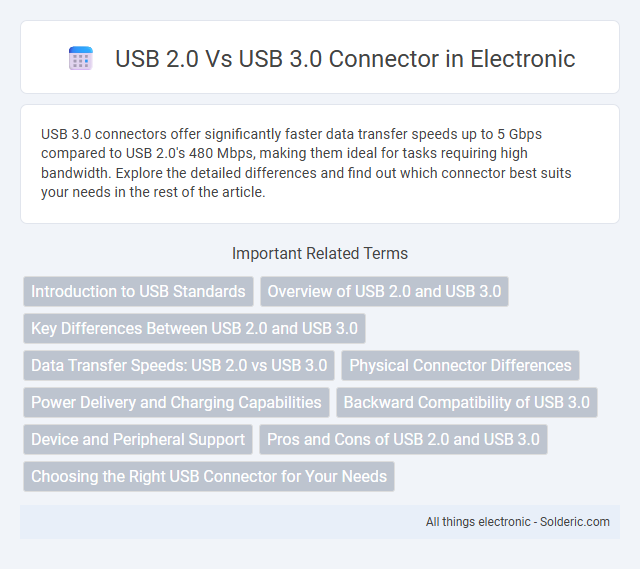USB 3.0 connectors offer significantly faster data transfer speeds up to 5 Gbps compared to USB 2.0's 480 Mbps, making them ideal for tasks requiring high bandwidth. Explore the detailed differences and find out which connector best suits your needs in the rest of the article.
Comparison Table
| Feature | USB 2.0 | USB 3.0 |
|---|---|---|
| Max Data Transfer Rate | 480 Mbps | 5 Gbps |
| Connector Color | Black or White | Blue (Standard) |
| Pin Count | 4 pins | 9 pins |
| Power Output | 500 mA at 5V | 900 mA at 5V |
| Backward Compatibility | Compatible with USB 1.1 devices | Compatible with USB 2.0 and 1.1 devices |
| Data Transfer Mode | Half-duplex | Full-duplex |
| Typical Use Cases | Basic peripherals (keyboards, mice) | High-speed devices (external SSDs, HD webcams) |
Introduction to USB Standards
USB 2.0 introduced a data transfer rate of up to 480 Mbps, significantly improving connectivity speed compared to its predecessors. USB 3.0 expanded this capability to 5 Gbps, enabling faster data transfer and better performance for high-bandwidth devices. These standards also differ in connector design, with USB 3.0 featuring additional pins to support increased power delivery and improved data signaling.
Overview of USB 2.0 and USB 3.0
USB 2.0 supports data transfer speeds up to 480 Mbps, making it suitable for basic peripherals like keyboards and mice, while USB 3.0 significantly enhances performance with transfer rates up to 5 Gbps, ideal for high-speed storage devices and video streaming. The USB 3.0 connector features additional pins for faster data transfer and improved power efficiency, ensuring better overall connectivity. Your choice between USB 2.0 and USB 3.0 connectors should depend on the required speed and device compatibility.
Key Differences Between USB 2.0 and USB 3.0
USB 3.0 connectors feature nine pins compared to USB 2.0's four pins, enabling data transfer speeds up to 5 Gbps, which is approximately ten times faster than USB 2.0's 480 Mbps. USB 3.0 also provides increased power output of up to 900 mA for faster device charging, whereas USB 2.0 supplies only 500 mA. The physical design of USB 3.0 connectors includes additional internal contacts and is often identifiable by blue plastic, distinguishing it from the typically black or white USB 2.0 connectors.
Data Transfer Speeds: USB 2.0 vs USB 3.0
USB 2.0 supports data transfer speeds up to 480 Mbps, while USB 3.0 significantly increases this to 5 Gbps, offering over ten times faster throughput. The enhanced speed of USB 3.0 is achieved through additional data lanes and improved signaling protocols. These advancements enable quicker file transfers and better performance for high-bandwidth devices like external hard drives and video interfaces.
Physical Connector Differences
USB 2.0 connectors typically feature a rectangular Type-A design with four pins, while USB 3.0 connectors include additional pins to support higher data transfer speeds, totaling nine pins in Type-A connectors. The USB 3.0 Type-A connector is physically distinguishable by its blue color and extra pins within the same form factor as USB 2.0. USB 3.0 also introduces Type-B and Micro-B connectors with different shapes that accommodate more pins for enhanced performance and faster data transfer rates.
Power Delivery and Charging Capabilities
USB 3.0 connectors provide improved power delivery compared to USB 2.0, offering up to 900mA current at 5V versus USB 2.0's 500mA, enabling faster charging of connected devices. Enhanced power management in USB 3.0 supports better efficiency and can deliver more stable power to peripherals requiring higher energy. This increased power output allows USB 3.0 to support a broader range of devices with demanding charging needs, making it preferable for high-performance charging applications.
Backward Compatibility of USB 3.0
USB 3.0 connectors are fully backward compatible with USB 2.0 ports and devices, allowing seamless data transfer and charging without the need for new cables or adapters. The design ensures that your USB 3.0 devices can operate at USB 2.0 speeds when connected to older ports, preserving functionality across different hardware generations. This backward compatibility helps protect your investment in USB 3.0 technology while maintaining broad device support.
Device and Peripheral Support
USB 3.0 connectors offer enhanced device and peripheral support compared to USB 2.0 by enabling faster data transfer speeds up to 5 Gbps, which significantly improves performance for high-bandwidth devices like external hard drives and HD webcams. USB 3.0 also provides better power delivery, allowing you to charge compatible peripherals more efficiently and support devices requiring higher power levels. Both connectors remain backward compatible, ensuring seamless connectivity with a wide range of existing USB 2.0 devices and peripherals.
Pros and Cons of USB 2.0 and USB 3.0
USB 2.0 connectors offer broad compatibility with older devices and lower cost, but they support a maximum data transfer rate of 480 Mbps, which limits performance for high-speed applications. USB 3.0 connectors provide significantly faster data transfer speeds up to 5 Gbps and improved power management, ideal for modern devices, yet they are typically more expensive and less compatible with legacy hardware without adapters. Choosing between USB 2.0 and USB 3.0 depends on balancing speed requirements, device compatibility, and budget constraints.
Choosing the Right USB Connector for Your Needs
USB 3.0 connectors offer significantly faster data transfer speeds up to 5 Gbps compared to USB 2.0's 480 Mbps, making them ideal for high-speed external storage and HD video streaming. USB 3.0 ports feature additional pins and a distinct blue color to differentiate them from USB 2.0, ensuring compatibility and optimal performance with modern devices. Choosing the right USB connector depends on your data transfer requirements and device compatibility, with USB 2.0 suitable for basic peripherals and USB 3.0 preferred for demanding multimedia and faster charging needs.
USB 2.0 vs USB 3.0 connector Infographic

 solderic.com
solderic.com